Back Pain & Neck Pain Disorders
From Chronic Back Pain to Sciatica, Bulging Discs and trapped nerves, we can help with a range of conditions Book An AppointmentOn this page you will find info on Back Pain, Neck Pain and related disorders such as bulging discs, sciatica and trapped nerves that we can help with. See full list below.
- Back Pain
- Neck Pain
- Facet Joint Pain
- Sciatica
- Piriformis Syndrome
- Trapped Nerves
- Sacro-iliac Joint Pain
- Spondylolisthesis
- Coccydinia
- Bulging, Herniated & Prolapsed Discs (Disc Protrusion) and radiculopathy
- Degenerative Discs (Spondylosis)
- Stenosis
For other conditions we can help with please click on a link below

At Spine Plus we offer a wealth of experience, treatment options and specialist therapy equipment for dealing with back pain disorders within our clinics.
Whenever possible and appropriate we will offer the highest quality hands-on treatment, and often combine treatment for back pain with IDD Therapy, Osteopathy, Shockwave Therapy, , TECAR,or LASER depending on your individual needs.Furthermore, case we can’t help you in-house we will likely know the right specialist or centre to recommend / refer to if you need a specialist opinion or scan.
This is made possible by virtue of the close working relationships we have established of with several of London’s leading pain doctors, radiologists and surgeons.
Back Pain Treatment
Back pain is arguably the most common and most costly musculoskeletal condition society faces today. Not only can it be extremely debilitating for sufferers but it can be one the most complex conditions for clinicians to understand and deal with. The human spine with it’s numerous muscles, ligaments, joints, discs and nerves, all integrating and interplaying with each other, is an amazingly complex mechanical structure. Little wonder that a “one size fits all” approach so often fails when it comes to dealing with back pain. At Spine Plus we pride ourselves on succeeding where other organisations fail. We offer a multi-modality approach that may include hands on treatment consisting of bespoke deep massage, stretching and manipulation, alongside medical acupuncture, electrotherapy & mechanical treatments, as well as corrective exercise advice.
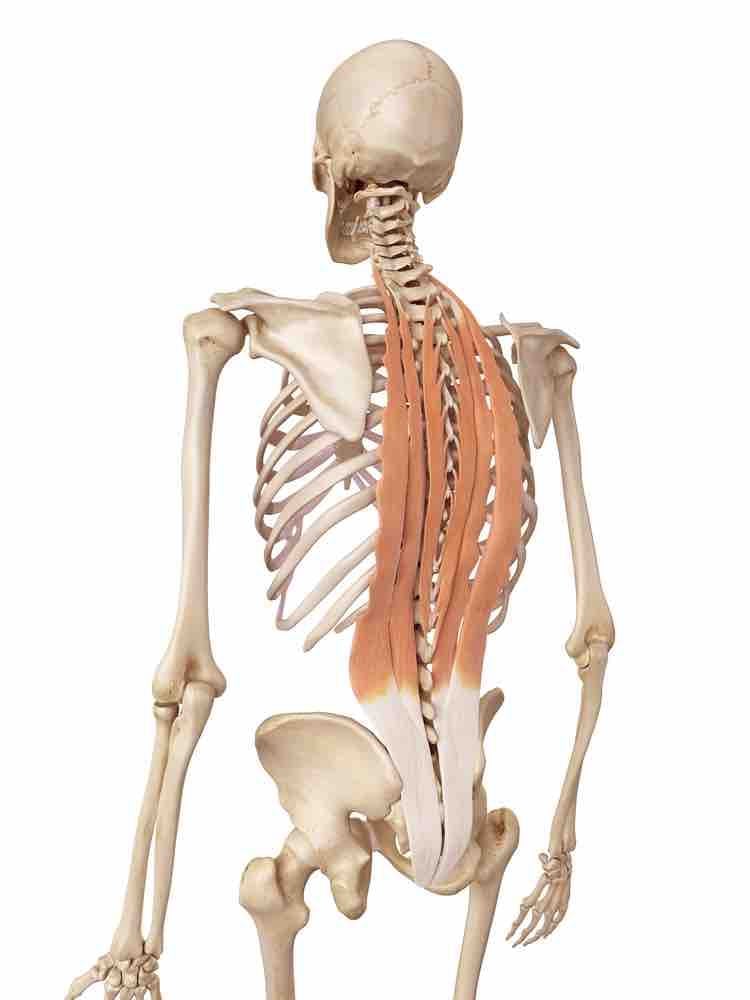
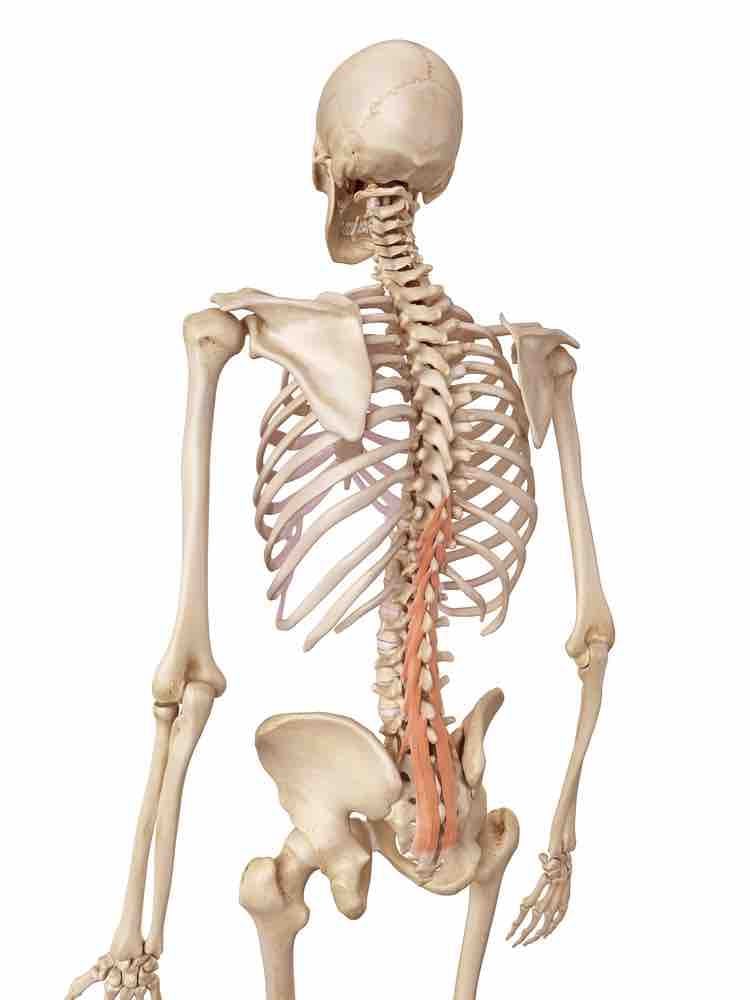
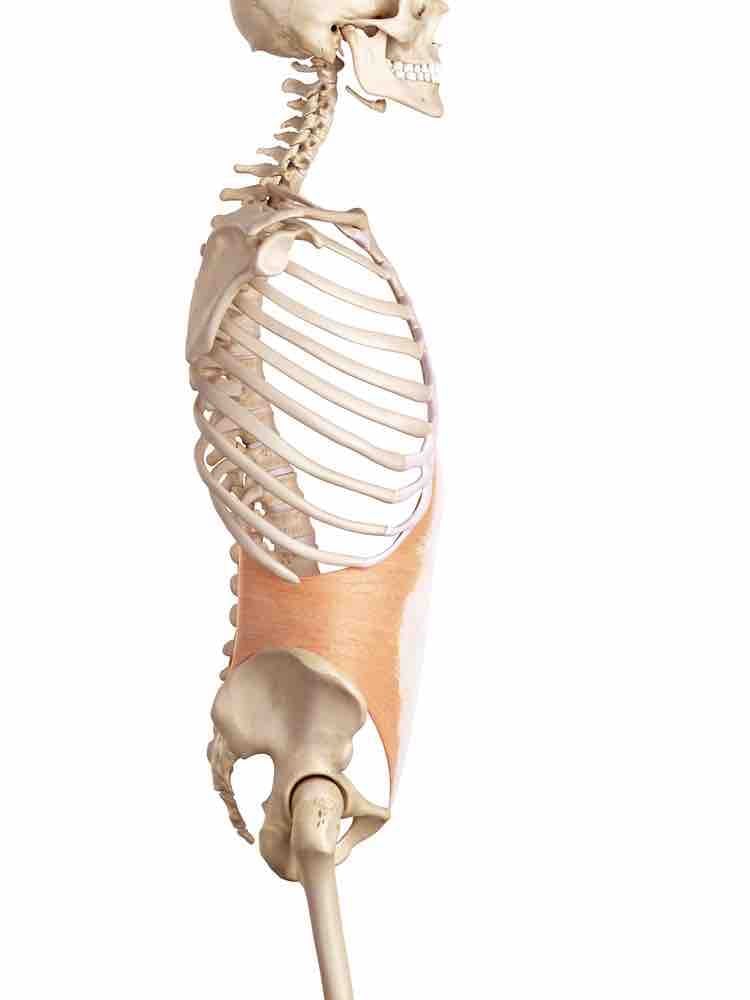
Neck Pain Treatment
Sources of neck pain can range from simple muscular strains requiring remedial massage to more degenerative conditions such as Facet joint and ligament problems that require additional treatment and advice. Common causes are trauma from whiplash injuries or problems may arise due to poor posture related such as in “text neck”. The key to successful treatment is identifying and treating the pain source, as well as the factors that have led to its formation.
Facet Joint Pain
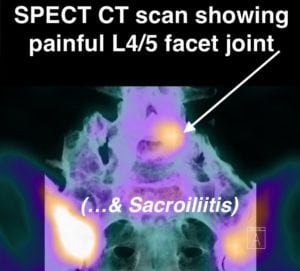 The Facet joints are the small knuckle sized joints that occur on the left and right of each intervertebral segment of spine. Just like the knuckle joints these joints can become inflamed, painful, arthritic and even locked and jammed into a fixed position (this is referred to as Facet lock, subluxation or misalignment). Although it’s not exclusive to facet joint pain common signs include pain to one side of the spine that is brought in by bending backwards and to the side of the pain since this movement tends to maximally approximate the surfaces of the facet joint. Manual therapy treatment techniques will include gapping techniques to help open up the joints, manipulation where required, as well deep massage and dry needling as necessary to release associated muscle knots causing pain and tension in and around the facet joint(s).
The Facet joints are the small knuckle sized joints that occur on the left and right of each intervertebral segment of spine. Just like the knuckle joints these joints can become inflamed, painful, arthritic and even locked and jammed into a fixed position (this is referred to as Facet lock, subluxation or misalignment). Although it’s not exclusive to facet joint pain common signs include pain to one side of the spine that is brought in by bending backwards and to the side of the pain since this movement tends to maximally approximate the surfaces of the facet joint. Manual therapy treatment techniques will include gapping techniques to help open up the joints, manipulation where required, as well deep massage and dry needling as necessary to release associated muscle knots causing pain and tension in and around the facet joint(s).
Sciatica Treatment
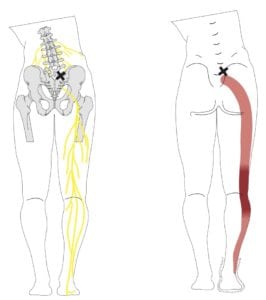 “Sciatica” refers to pain usually felt down the back of the leg due to entrapment of the “sciatic nerve”. The sciatic nerve is the largest nerve in the body, it is formed by nerve roots in the lower back which join to form the sciatic nerve in the buttock or gluteal region, from there branches of the sciatic the nerve extend into the leg as far as the toes. Sciatica can be due to pinching at any branch of the nerve or nerve roots. The most common cause of sciatica is a protruding disc (alternatively referred to as a bulging, herniated, or prolapsed disc) pressing on one of the nerve roots in the lower back (see Treatment for Bulging, Herniated & Prolapsed Discs Protrusions). Sciatica can also be caused by entrapment of the sciatic nerve in the buttock between or within the the muscles of the buttock (see Piriformis Treatment).
“Sciatica” refers to pain usually felt down the back of the leg due to entrapment of the “sciatic nerve”. The sciatic nerve is the largest nerve in the body, it is formed by nerve roots in the lower back which join to form the sciatic nerve in the buttock or gluteal region, from there branches of the sciatic the nerve extend into the leg as far as the toes. Sciatica can be due to pinching at any branch of the nerve or nerve roots. The most common cause of sciatica is a protruding disc (alternatively referred to as a bulging, herniated, or prolapsed disc) pressing on one of the nerve roots in the lower back (see Treatment for Bulging, Herniated & Prolapsed Discs Protrusions). Sciatica can also be caused by entrapment of the sciatic nerve in the buttock between or within the the muscles of the buttock (see Piriformis Treatment).
Piriformis Treatment
“Piriformis” is the name of one of the deep muscles in the buttock that acts on the hip joint. The muscle runs very close to the sciatic nerve and in some people the nerve even passes directly through the middle of the muscle. Knots and tension in this and / or the neighbouring muscles (such as the “Gluteal, Obturator and Gemellus” muscles) can trap the sciatica nerve to cause sciatica (Piriformis Syndrome). Successful treatment usually includes precisely applied deep massage and acupressure techniques to release knots and tension within these muscles. If the muscle knots (Trigger Points) are unresponsive or in a hard to reach part of the muscle with hands only techniques, then we can also offer our patients dry needling (medical acupuncture) to target deep or stubborn trigger points.
Treatment For Trapped Nerves
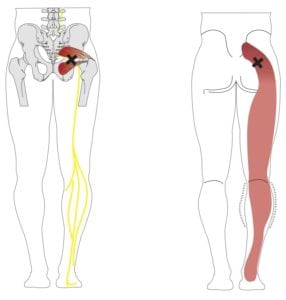 Sciatica and piriformis syndrome are examples of trapped nerves with in the lower back and buttock, however trapped nerves can occur elsewhere in the body. Another common site is impingement of nerve roots in the neck from degenerative discs and facet joints. One of the most effective treatments we offer to relieve symptoms for these conditions is traction based techniques (including IDD Therapy). Other types of trapped nerve can occur in more peripheral sites of the body, where nerves can become pinched or trapped between various tissue and sinews. Examples include carpal tunnel syndrome in the wrist and entrapment of a branch of the “radial nerve” in the radial channel at the elbow (often involving tension in the “supinator” muscle, a common feature in patients with tennis elbow). Similarly peripheral branches of the “median nerve’ can become pinched and irritated by tension in the “pronator teres” muscle in the forearm / elbow, and in the foot “Morton’s neuroma” may be an associated condition in people with dropped arches.
Sciatica and piriformis syndrome are examples of trapped nerves with in the lower back and buttock, however trapped nerves can occur elsewhere in the body. Another common site is impingement of nerve roots in the neck from degenerative discs and facet joints. One of the most effective treatments we offer to relieve symptoms for these conditions is traction based techniques (including IDD Therapy). Other types of trapped nerve can occur in more peripheral sites of the body, where nerves can become pinched or trapped between various tissue and sinews. Examples include carpal tunnel syndrome in the wrist and entrapment of a branch of the “radial nerve” in the radial channel at the elbow (often involving tension in the “supinator” muscle, a common feature in patients with tennis elbow). Similarly peripheral branches of the “median nerve’ can become pinched and irritated by tension in the “pronator teres” muscle in the forearm / elbow, and in the foot “Morton’s neuroma” may be an associated condition in people with dropped arches.
Sacro-iliac Joint Pain Treatment
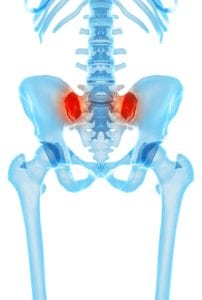 The sacro-iliac joints occur where the sacrum (as the base of the spine) joins the ilium bones of the pelvis. The joints can be a pain source if degenerate or arthritic although in our experience patients are often told they have “sacro-iliac” dysfunction or that their pelvis is “misaligned” when in fact subsequent scans reveal they are actually suffering with and L5/S1 disc or facet problem in the lower back. There are instances when these joints can become genuinely misaligned and will respond to manipulation, though this is most commonly associated with pregnancy due to the fact that the ligaments of the pelvic have become slackened under the influence of hormones produced during pregnancy. A similar condition can occur at the pubic joint in the front of the pelvis (“Osteitis Pubis” or “Symphysis Pubis Dysfunction”). Our clinicians have the experience and expertise to make accurate judgments on the most likely diagnosis, appropriate treatments and referrals for further tests or specialists (if required).
The sacro-iliac joints occur where the sacrum (as the base of the spine) joins the ilium bones of the pelvis. The joints can be a pain source if degenerate or arthritic although in our experience patients are often told they have “sacro-iliac” dysfunction or that their pelvis is “misaligned” when in fact subsequent scans reveal they are actually suffering with and L5/S1 disc or facet problem in the lower back. There are instances when these joints can become genuinely misaligned and will respond to manipulation, though this is most commonly associated with pregnancy due to the fact that the ligaments of the pelvic have become slackened under the influence of hormones produced during pregnancy. A similar condition can occur at the pubic joint in the front of the pelvis (“Osteitis Pubis” or “Symphysis Pubis Dysfunction”). Our clinicians have the experience and expertise to make accurate judgments on the most likely diagnosis, appropriate treatments and referrals for further tests or specialists (if required).
Spondylolisthesis (and retro-listhesis)
Spondylolisthesis refer the slipping forward of one vertebra relative to the vertebra below (a “retrolisthesis” means it has shifted backwards). Such misalignments of the vertebra tend to fixed (i.e. won’t change) and are often secondary to degenerative changes in the discs, facet joints, ligaments and bone (lamina) which may consequentially be strained and inflamed. There is often much that can be done to help settle symptoms associated with a spondylolisthesis ranging from techniques to promote mobility in other segment of the spine that if stiff could be contributing too much movement going through the segment with the spondylolisthesis, to muscle re-education and re-organisation and specific stretches that can be taught to help alleviate pressure on the segment concerned.
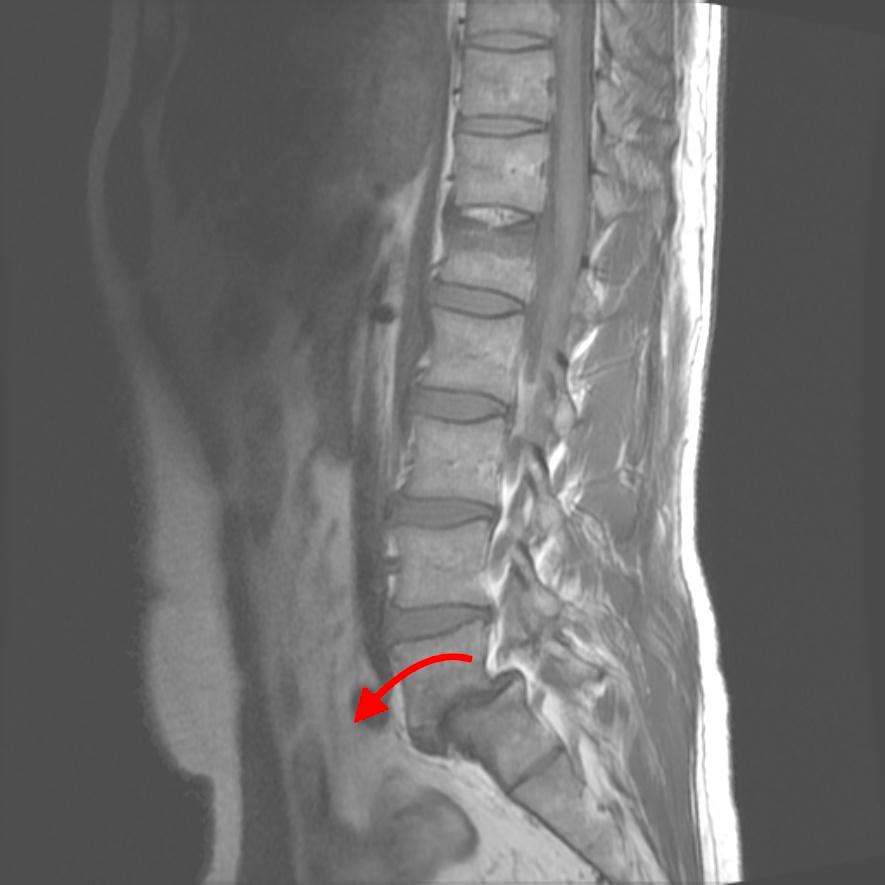
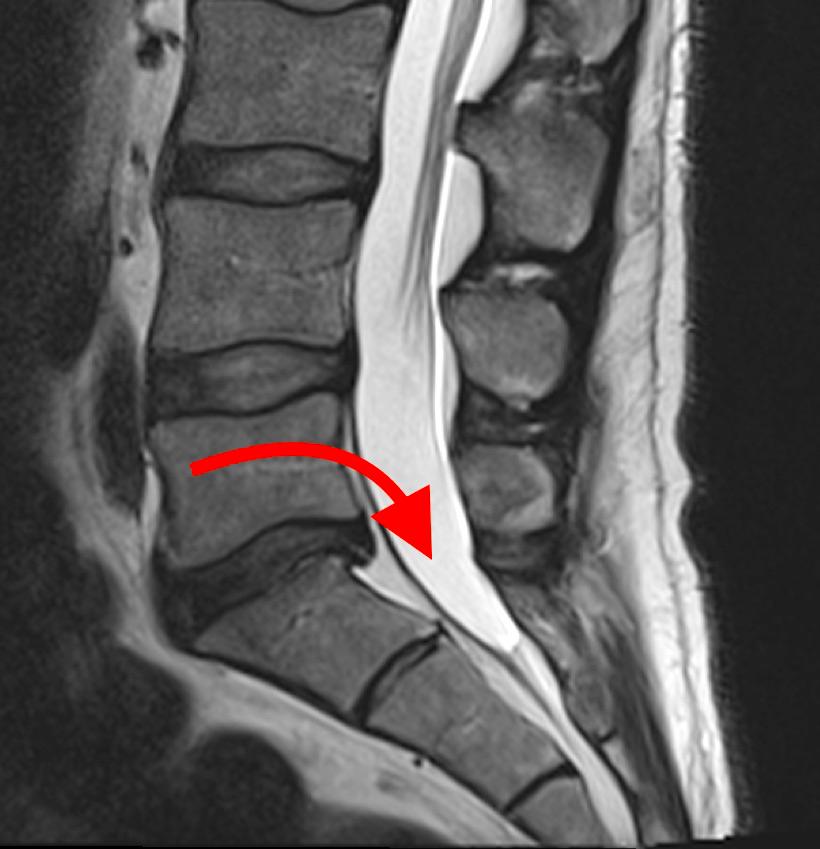
Coccydinia
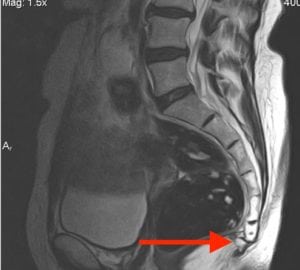 Pain around the tail bone or coccyx can result from either an usually long or “bony” coccyx without much soft tissue covering or from definitive subluxation of the coccyx itself. The latter can be a feature of injuries involving a heavy fall on the bottom or from repetitive microtrauma to the supporting ligaments of the sarco-coccygeal joint allowing the coccyx to shift out of position (usually inwards, as shown on the MRI scan). Treatment options offered to patients within a hospital setting commonly include injections or manipulation under anaesthetic, however this condition often responds surprisingly well to gentle osteopathic (internal / per rectal) manipulation to coax the coccyx back into place.
Pain around the tail bone or coccyx can result from either an usually long or “bony” coccyx without much soft tissue covering or from definitive subluxation of the coccyx itself. The latter can be a feature of injuries involving a heavy fall on the bottom or from repetitive microtrauma to the supporting ligaments of the sarco-coccygeal joint allowing the coccyx to shift out of position (usually inwards, as shown on the MRI scan). Treatment options offered to patients within a hospital setting commonly include injections or manipulation under anaesthetic, however this condition often responds surprisingly well to gentle osteopathic (internal / per rectal) manipulation to coax the coccyx back into place.
Treatment for Bulging, Herniated & Prolapsed Discs (Disc Protrusion) and radiculopathy
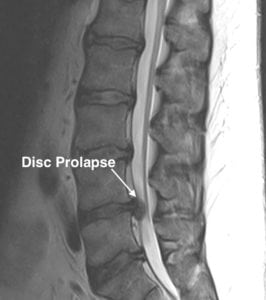 Fibrocartilage discs exist at every level of the spine, they help provide cushioning, movement and space between the bony segments (vertebrae) and nerves exiting between the vertebrae. However, over time, whether due to poor posture, poor lifting techniques or weak core muscles, these discs can become strained causing them to buckle or bulge (this may referred to a broad based disc bulge, disc protrusion or disc prolapse). If this process involves tearing of the disc material (annular tear) this may be revealed by a “High Intensity Zone” or “HIZ” on an MRI scan (note this will not show on x-ray), indicating a potential pain source from the disc itself. However, pain may not occur until a disc bulge is large enough to press on the adjacent nerve root. When this occurs this will cause nerve pain (radiculopathy) most often felt as pain down one leg (sciatica). In our experience deloading the disc through decompression or traction treatments (including IDD Therapy available at our clinics) can often provide very productive long term pain relief. It is also very important to address any failings in core muscle strength, poor posture (such as slouching) and poor lifting techniques. Our practitioners will provide one to one advice on this alongside manual therapy (also see Books & Guides for more info, including our free to download leaflets).
Fibrocartilage discs exist at every level of the spine, they help provide cushioning, movement and space between the bony segments (vertebrae) and nerves exiting between the vertebrae. However, over time, whether due to poor posture, poor lifting techniques or weak core muscles, these discs can become strained causing them to buckle or bulge (this may referred to a broad based disc bulge, disc protrusion or disc prolapse). If this process involves tearing of the disc material (annular tear) this may be revealed by a “High Intensity Zone” or “HIZ” on an MRI scan (note this will not show on x-ray), indicating a potential pain source from the disc itself. However, pain may not occur until a disc bulge is large enough to press on the adjacent nerve root. When this occurs this will cause nerve pain (radiculopathy) most often felt as pain down one leg (sciatica). In our experience deloading the disc through decompression or traction treatments (including IDD Therapy available at our clinics) can often provide very productive long term pain relief. It is also very important to address any failings in core muscle strength, poor posture (such as slouching) and poor lifting techniques. Our practitioners will provide one to one advice on this alongside manual therapy (also see Books & Guides for more info, including our free to download leaflets).
Treatment for Degenerative Disc (spondylosis)
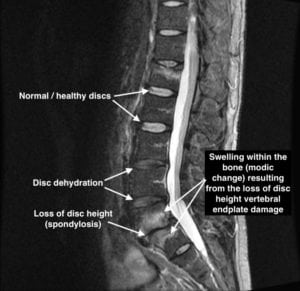 Spondylosis refers to thinning and dehydration of the discs often shown as “black discs” on an MRI scan devoid of the normal hydrated (jelly like) nucleus (which shows up as light grey on an MRI scan). To some extent this a normal part of the aging process and may not in itself cause direct pain. However, if just one, or a few discs are seen to be prematurely spondylotic this may indicate adverse mechanical forces acting on that segment due perhaps to tight local muscles, weak core muscles and suboptimal posture and movement patterns causing hinging at that segment. Unravelling and addressing the various factors that are contributing each individual’s case is what we do best!
Spondylosis refers to thinning and dehydration of the discs often shown as “black discs” on an MRI scan devoid of the normal hydrated (jelly like) nucleus (which shows up as light grey on an MRI scan). To some extent this a normal part of the aging process and may not in itself cause direct pain. However, if just one, or a few discs are seen to be prematurely spondylotic this may indicate adverse mechanical forces acting on that segment due perhaps to tight local muscles, weak core muscles and suboptimal posture and movement patterns causing hinging at that segment. Unravelling and addressing the various factors that are contributing each individual’s case is what we do best!
Treatment for Spinal Stenosis (and Foraminal Stenosis)
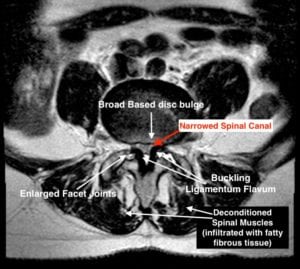 Each bony segment of the spine (vertebra) forms a ring of bone called the spinal canal through which the spinal cord and spinal nerve pass. If the hole or canal formed by this ring of bone becomes narrowed this is referred to as “spinal stenosis”. Spinal stenosis can cause pain in the legs similar to sciatica although the distinctive feature of spinal stenosis is that the pain usually only comes on during activity such as walking. Appropriate treatment will depend on exactly what is causing the narrowing of the canal, whether it be a central disc protrusion, buckling ligaments (ligamentum flavum) due to spondylosis, bony overgrowth from arthritic facet joints, a congenitally small canal or a combination of all these factors.
Each bony segment of the spine (vertebra) forms a ring of bone called the spinal canal through which the spinal cord and spinal nerve pass. If the hole or canal formed by this ring of bone becomes narrowed this is referred to as “spinal stenosis”. Spinal stenosis can cause pain in the legs similar to sciatica although the distinctive feature of spinal stenosis is that the pain usually only comes on during activity such as walking. Appropriate treatment will depend on exactly what is causing the narrowing of the canal, whether it be a central disc protrusion, buckling ligaments (ligamentum flavum) due to spondylosis, bony overgrowth from arthritic facet joints, a congenitally small canal or a combination of all these factors.
